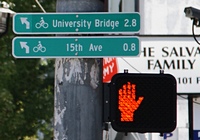
The project, one of the first of its kind in the United States, was commissioned by King County, Wash., to update its prior greenhouse gas inventory and provide a more complete picture of how people in the county contribute to global climate change – and what local leaders can do about it.
SEI U.S. Centre researchers in Seattle and Boston worked with local officials to analyze the county’s greenhouse gas emissions by two very different measures.
The standard inventory, similar to that of other communities, measured emissions from transportation, buildings, industry, and waste disposal by King County residents and businesses – mostly released within the county itself – and tallied them at 12 tons of GHG emissions per resident.
The consumption-based inventory, led by SEI’s Liz Stanton, looked at emissions associated with all goods and services consumed in King County, regardless of where they were produced: personal transportation, food, furniture and electronics, health care, etc. The total was 29 tons per resident, about the same as the U.S. average, but over four times the global average.
“This new study changes the way we look at our carbon footprint,” said King County Executive Dow Constantine in releasing the results.
Many of the sources of King County’s emissions, however, are beyond local officials’ direct influence, notes Peter Erickson, an SEI senior scientist and lead author of the report. Thus the study included one more crucial piece: an analysis of which emission sources – from both inventories – can be directly influenced by local governments, and how to track them over time.

The project team developed a new tracking framework that focuses on a “core” set of emission sources: local building energy use, vehicle travel, and waste disposal. All can be tracked annually, Erickson says, using data that are, for the most part, readily available from local utilities and planning agencies. The framework also includes a set of supplementary metrics, such as vehicle travel and building energy use per resident, to support analysis of yearly trends and drivers.
“Local governments have profound influence over the form of urban areas – from land use codes, to transportation systems and building energy performance,” Erickson says.
“This study sets up a new framework for King County to use to track progress over time in the sources of emissions that are most sensitive to local government policy. It also helps quantify the impact of consumption, and in doing so, helps shed light on how consumer actions – from eating less meat to buying less stuff – can help reduce global emissions.”
Local governments may also operate education and outreach programs that can help reduce these types of emissions, whether through healthy eating or waste prevention, notes report co-author Chelsea Chandler.
Although the framework was developed for King County, it could be applied to any of the thousands of U.S. communities that are working to reduce their GHG emissions, Erickson says. There is no standard protocol or framework for tracking local-level greenhouse gas emissions in the U.S.
“King County has long been a leader on climate change adaptation and resilience, and this new work is highly innovative on the mitigation side of the equation,” Erickson says. “I think both the consumption-based inventory and the tracking framework could be highly influential.”
The consumption-based analysis was based on a similar study that SEI did for the State of Oregon. The King County framework, in turn, informed SEI’s recommendations to the City of Seattle on ways to meet the city’s goal of becoming “carbon-neutral.”
Design and development by Soapbox.

